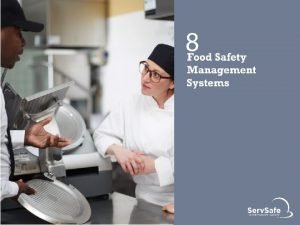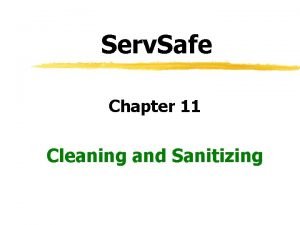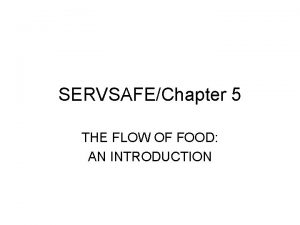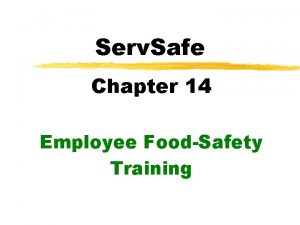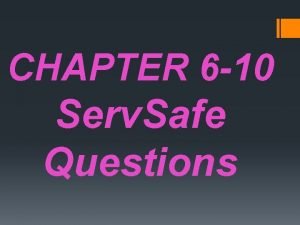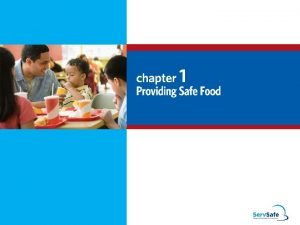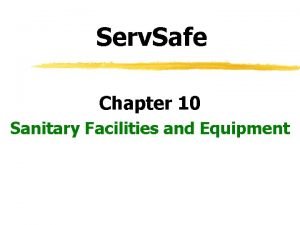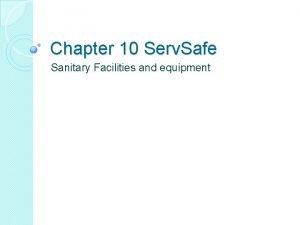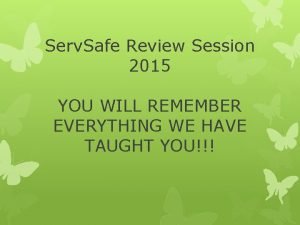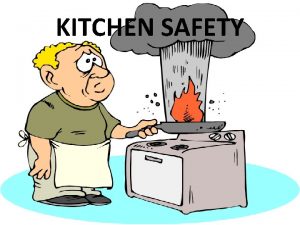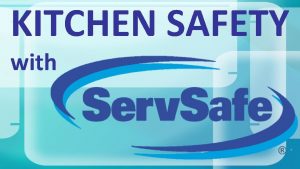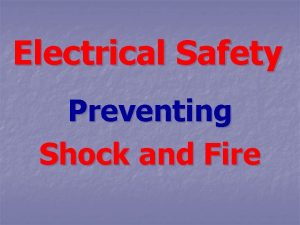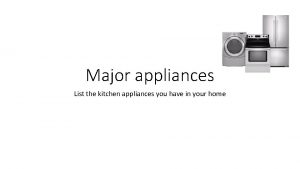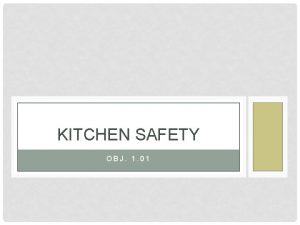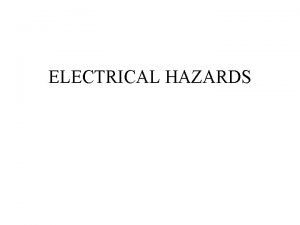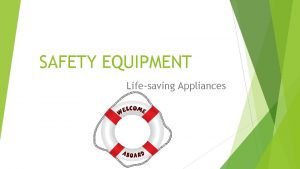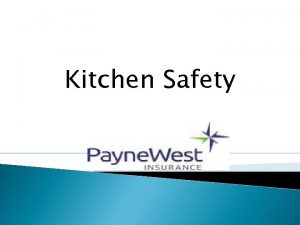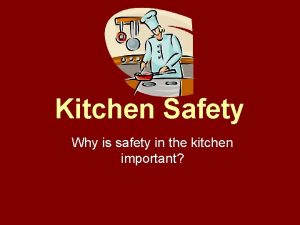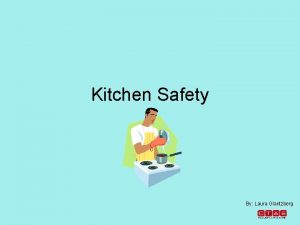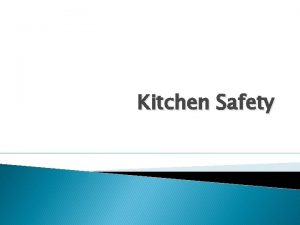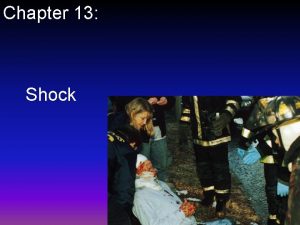SERVSAFE KITCHEN SAFETY ELECTRICAL APPLIANCES AND SHOCK Always





















- Slides: 21

SERVSAFE: KITCHEN SAFETY

ELECTRICAL APPLIANCES AND SHOCK • Always use DRY hands to use, move or touch. • Stand on a DRY floor • Never use appliance by water or under water. Keep all cords away from water as well. • Plug the removable cords in the appliance first, THEN into the power source. • Always pull the plug, not the cord or the base • FIRST-AID In case of electrocution: – TURN OFF MAIN POWER SOURCE; that means flip the breaker- BEFORE touching the person or the appliance.

KNIVES SAFETY AND CUTS • Use a SHARP knife, it’s safer • Use a stabilized cutting board (plastic is best!) • Store knives with a safety guard/sleeve, or in in knife rack/block • NEVER throw a knife, you should always set it down for others to pick up, carry it down by you side • Clean separately • Use a damp paper towel to clean up broken glass- not a broom! • FIRST-AID for cuts: – Apply DIRECT PRESSURE over the cut, then you can run it under cool water. If you need stitches for a deep cut, make sure you get that ASAP

GREASE FIRES AND BURNS • Keep clothing away from direct heat (that’s why tighter fitting clothes are better than loose clothing items) • Avoid paper/plastic on or near the stovetop (wood and silicone are better for less heat conduction and they are stronger) • ALWAYS use dry hot pads/oven mitts for handling hot pans/dishes • Lift lids AWAY from you (use the lid as shield) • Turn handles towards the inside or back of the stovetop • NEVER use water to put out a kitchen fire!!!!!!! Also avoid sugar and flour. – Use the lid to smother it – Use a fire extinguisher – Use Salt, or Baking SODA • FIRST-AID for a burn: run it under cool, running water. Not too cold, not too hot, and see a doctor ASAP if it creates a blister or bubbles


TRIPS, SLIPS AND FALLS • Clean up spills as soon as they happen! • Use a step stool to reach things in high places, NEVER use anything on wheels or with an unstable surface. • Store heavy items on lower shelves. • Use non-skid, close-toed shoed with tied shoelaces or Velcro • Make sure all matts are laying flat and the floor is clear of debris

CLEANING SUPPLIES AND CHEMICALS: POISONING • NEVER mix cleaning supplies – like bleach and ammonia: it creates a toxic deadly fume • Always store cleaning supplies away from food and cooking supplies like utensils and equipment • Keep cleaning chemicals in original containers, or have them labeled clearly. • FIRST-AID for Poisonings: – Have the original container handy, the amount taken, when it was taken, and call POISON CONTROL: 1 -800 -222 -1222

CLEANING AND SANITIZING

• Keep all work surfaces clean – Clean: removing any visible solids. This will help keep bugs away too • Disinfect/sanitize work surfaces to prevent cross-contamination – Disinfect: reduce unseen germs and bacteria with use of chemicals left on surfaces to work properly – Cross-contamination: transferring of bad bacteria from one thing to another • Clean and sanitize surfaces that are being used every 4 hours • Always use sanitizers and cleaners according to their directions • Store towels for cleaning food spills in sanitizer solution when you are not using them, never in your pockets or aprons • Use a test kit to check the strengths and ensure it’s working correctly. • To properly sanitize: – Clean the surface – Rinse the surface – Sanitize the surface

GERMS • Stop the spreading of germs by using a clean utensil when tasting foods, and only use it ONCE. • Pathogens= microbes that cause foodborne illnesses in people. • 3 types of food contaminates: – 1. Biological – living organisms like fungi (mold), bacteria, viruses, etc – 2. Chemical- solutions, toxic metals, pesticides. These cause poisonings, cancer, burnings. – 3. Physical- broken glass, metal pieces, band-aids

WHEN TO WASH YOUR HANDS After using the restroom After coughing or sneezing Before & after handling raw meat, poultry, or eggs Before putting on gloves After touching clothing or aprons After handling money After handling garbage or trash After handling dirty equipment/utensils Before, during AND after food preparation

HAND WASHING- 20 SECONDS • Wet hands and fore-arms with warm/hot water. • Apply soap • Scrub hands and arms for at least 15 seconds • Rinse hands and arms • Use an antiseptic (hand sanitizer) after washing hands • Wait for the antiseptic to dry before touching food or equipment, and before putting on gloves. • Singing the ABC’s, Twinkle-Twinkle Little Star, or Happy Birthday can help you gage your time

DRYING HANDS • Dry hands and arms with paper towel • Do not use an apron, cloth towel, or clothes to dry hands (these contain bacteria) • Use the paper towel to turn off the faucet and open doors

HANDWASHING SINK – If your work place has a handwashing sink: the handwashing sink is to be used for handwashing only – Never use the designated handwashing sink for other purposes.

WEARING GLOVES • Avoid bare-hand contact with ready to eat foods (pre-packaged) • Wear gloves if you have open sores or cuts on our hands – A bandage must cover the wound completely and a glove must be worn over the bandage. • Use the correct size glove so they fit and do not rip or get stuck. • Never rinse, wash or reuse gloves. • Wash hands before putting on gloves and when changing to a new pair. • Change gloves with each new task.

CLOTHING, HAIR AND JEWELRY • Wear a CLEAN apron and clothing to prevent spreading of germs • Tie hair back or cover hair • Remove all jewelry from hands and arms, including rings, bracelets and watches. – The ONLY exception is a plain band ring

DISHWASHING – BY HAND • Wash dishes in the following order: – Rinse and Scrape Food – Glassware – Silverware – Dishware (plates, bowls) – Kitchen tools – Pots and Pans

DISH WASHING- 3 SINK METHOD

DISH WASHING-- DISH MACHINE • Dish Machines are used in the industry to quickly clean and sanitize dishes – Scrape, rinse or soak items before washing. – Never overload the dish racks and use the correct racks – Frequently check water temperature and pressure – Change the water when necessary

STORING DISHES AND UTENSILS • Store in a clean, dry location • Store at least 6 -inches above the floor • Store upside down on a clean, sanitized surface. • If storing utensils vertically, store them with handles up.

TRASH AND GARBAGE • Remove the garbage from prep area as quickly as possible. • Do not clean garbage containers in or near food prep areas. • Use trashcan liners. • Clean the inside and outside of garbage containers often. • Close the lids on outdoor containers.
 Shutterstock
Shutterstock Midea kitchen appliances
Midea kitchen appliances Food safety management systems servsafe chapter 8 notes
Food safety management systems servsafe chapter 8 notes Site:slidetodoc.com
Site:slidetodoc.com Diferencia entre shock medular y shock neurogenico
Diferencia entre shock medular y shock neurogenico Spinal shock vs neurogenic shock
Spinal shock vs neurogenic shock T10 spinal cord
T10 spinal cord Subacute combined degeneration
Subacute combined degeneration Michelle felt an electrical shock when she was ironing
Michelle felt an electrical shock when she was ironing Prepositions of place kitchen
Prepositions of place kitchen In the kitchen or at the kitchen grammar
In the kitchen or at the kitchen grammar What is the definition of sanitizing servsafe
What is the definition of sanitizing servsafe Shellstock identification tags
Shellstock identification tags Low prices always
Low prices always Flow of food steps
Flow of food steps A key element to a successful training program is servsafe
A key element to a successful training program is servsafe Kckcc
Kckcc Signage posted at a handwashing station must include
Signage posted at a handwashing station must include Servsafe temperature chart
Servsafe temperature chart In keeping equipment and facilities safe and sanitary
In keeping equipment and facilities safe and sanitary Cross connection servsafe
Cross connection servsafe Tcs food
Tcs food


